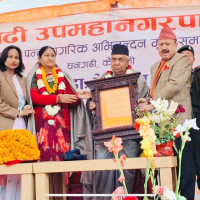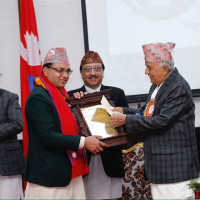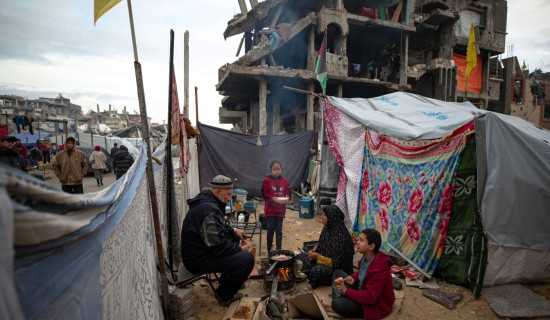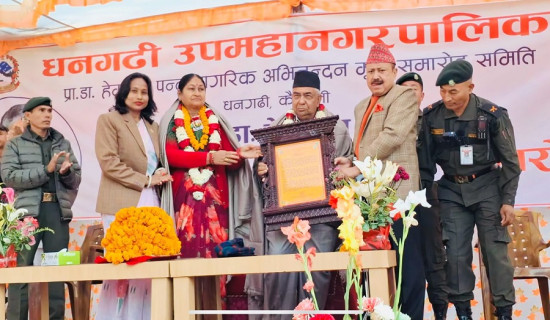- Thursday, 13 February 2025
Rupika : A New Brick In Nepali Literature
When one hears the name "Rupika," their mind immediately assumes that the story is about some sort of close relationship, possibly a romantic one. The initial assumptions, however, are quickly disproved as one reads more into the plot. The book "Rupika," written by Keshav Ghimire, stands out as a remarkable accomplishment. Ghimire deserves a sincere compliment for his unwavering commitment to this literary achievement.
As one reads through the pages of "Rupika," a resonant sentiment comes to light. This work adds a significant brick to the ever-expanding structure of Nepali literature. At its centre, the story forges an extraordinary connection between families that are situated in disparate social classes, demonstrating the transformational power of harmony and cooperation. 'Rupika,' a crucial character who serves as the story's girlfriend, has a deep bond with 'Keshar,' another essential figure. This story deftly depicts the blending of Sharma's and Kaji's families, demolishing the tendency to marginalise people from less wealthy origins.
The representation of the name "Rupika" in the book as an attractive, graceful, and sympathetic young woman adds a subtle layer of significance since it bears an air of rarity beneath the surface. Even though 'Rupika' is frequently referred to as a love story by some readers, a wider lens exposes the possibility of considering 'Rupika' as a social allegory mirroring the complexities of societal dynamics and events.
It's fascinating how a certain geographic setting is used on purpose. The narrative's tapestry clearly shows how Kamala Khuj is portrayed in the Sindhuli region in a genuine manner.
While there are few allusions to Kathmandu's surroundings, most of the story takes place on Kamala Khuj's canvas, gently transforming the book into a regional overview. This might be a sign of the author's close relationship with the place or a conscious effort to highlight the place's inherent significance.
The narrative begins the journey with an introduction to Kajiba, which will act as a compass to guide the reader through the complex maze of social and cultural conundrums in Kamala Khuj. Readers can easily immerse themselves in the atmosphere of the village thanks to the author's expert sketching of its surroundings.
As the story develops, a wide array of characters representing many classes, languages, and cultures adds depth to the plot. Even in the face of difficulties, the fundamental bond between Keshar
and Rupika is still discernible amidst these differences.
The interactions Keshar has with Kajiba's family while helping out around the house are noteworthy because they add closeness and sincerity to the story. The conversations between Keshar and Rupika are equally charming, flawlessly fusing passion and emotion. Ghimire's entry into the novel as a character and presentation of his own point of view add levels of depth and encourage readers to investigate different perspectives inside the narrative.
A common thread of love in its many manifestations can be felt throughout the multiplicity, giving the story hues of adoration and connection.
Conflicts, however, particularly those brought on by intercaste relations and familial dynamics, are woven throughout the story. Due to this, "Rupika" has the potential to be seen as a picture of pervasive caste discrimination, a significant problem in Nepali society. Readers are left wondering why these biases still exist in today's world despite advancements in education and society. It is definitely clear that the author wants to use literature's revolutionary potential to reveal the complex web of caste systems.
Ghimire's goal, however, goes beyond simply removing racial barriers; it also envisions a world freed from all restrictions. This goal occasionally appears in the story, possibly influenced by the author's progressive beliefs and inspiring revolutionary feelings. The mystery surrounding Kajiba's death infuses the narrative's broad canvas with an air of intrigue and power, enhancing the story's impact.
'Rupika' as a whole is a shining example of modern literary skill. The story has a few inherent quirks that result from the author's particular writing style and sporadic asides, but they may not be understood by everyone. The story's essence is subtly captured in the title, which also captures the narrative's smooth progression from beginning to end.
(The author is a journalist based in Bhaktapur.)















